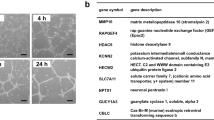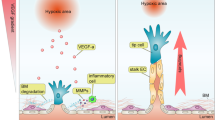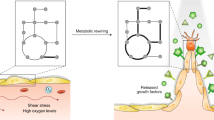Abstract
Angiogenesis, the formation of new capillaries, which is observed in embryonic and injured tissue and is particularly prominent in the vicinity of solid tumours1, involves the migration and proliferation of capillary endothelial cells. It is probably triggered by agents, such as basic fibroblast growth factor (bFGF), thought to be released from tissues adjacent to proliferating capillaries1. As well as being a potent inducer of cell division in capillary endothelial cells in vitro, bFGF can act as an angiogenic agent in vivo2. It is present in a wide variety of richly vascularized tissues including brain, pituitary, retina, adrenal gland, kidney, corpus luteum, placenta and various tumours1–3. So far, however, the normal bFGF-producing cell species in these tissues have not been identified2,4. We report here that capillary endothelial cells express the bFGF gene, that they produce and release bFGF and that bFGF derived from them can stimulate the proliferation of capillary endothelial cells. We conclude that bFGF can act as a self-stimulating growth factor for capillary endothelial cells, and that it is possible that the formation of new capillaries is induced by capillary endothelial cells themselves.
This is a preview of subscription content, access via your institution
Access options
Subscribe to this journal
Receive 51 print issues and online access
$199.00 per year
only $3.90 per issue
Buy this article
- Purchase on Springer Link
- Instant access to full article PDF
Prices may be subject to local taxes which are calculated during checkout
Similar content being viewed by others
References
Folkman, J. Cancer Res. 46, 467–473 (1986).
Gospodarowicz, D., Neufeld, G. & Schweigerer, L. Cell Diff. 19, 1–17 (1986).
Lobb, R. et al. J. biol. Chem. 261, 1924–1928 (1986).
Goustin, A. S., Leof, E. B., Shipley, G. D. & Moses, H. L. Cancer Res. 46, 1015–1029 (1986).
Gospodarowicz, D., Massoglia, S., Cheng, J. & Fujii, D. J. cell. Physiol. 127, 121–136 (1986).
Manger, B., Weiss, A., Weyand, C., Goronzy, J. & Stobo, J. J. Immun. 135, 3669–3674 (1985).
Shing, Y. et al. Science 223, 1296–1299 (1984).
Gospodarowicz, D., Cheng, J., Lui, G.-M., Barid, A. & Böhlen, P. Proc. natn. Acad. Sci. U.S.A. 81, 6963–6967 (1984).
Lobb, R. R. & Fett, J. W. Biochemistry 23, 6925–6929 (1984).
Böhlen, P., Esch, F., Baird, A. & Gospodarowicz, D. EMBO J. 4, 1951–1956 (1985).
Neufeld, G. & Gospodarowicz, D. J. biol. Chem. 260, 13860–13868 (1985).
Gospodarowicz, D., Massoglia, S., Cheng, J., Lui, G.-M. & Böhlen, P. J. cell. Physiol. 122, 323–333 (1985).
Abraham, J. A. et al. Science 233, 545–547 (1986).
Moenner, M., Chevallier, B., Badet, J. & Barritault, D. Proc. natn. Acad. Sci. U.S.A. 83, 5024–5028 (1986).
Olwin, B. B. & Hauschka, S. D. Biochemistry 25, 3487–3492 (1986).
Gospodarowicz, D. in Methods in Molecular and Cell Biology (eds Barnes, D., Sirbasku, D. & Sato, G.) 275–294 (Liss, New York, 1984).
Auron, P. E. et al. Proc. natn. Acad. Sci. U.S.A. 81, 7907–7911 (1984).
March, C. J. et al. Nature 315, 641–647 (1985).
Sporn, M. B. & Roberts, A. B. Nature 313, 745–747 (1985).
Baird, A., Mormede, P. & Böhlen, P. Biochem. biophys. Res. Commun. 126, 358–364 (1985).
Weber, E., Evans, C. J., Chang, J. K. & Barchas, J. J. Neurochem. 38, 436–447 (1982).
Goding, J. W. J. immunol. Meth. 13, 215–226 (1976).
Schweigerer, L. et al. Proc. natn. Acad. Sci. U.S.A. (submitted).
Maniatis, T., Fritsch, E. F. & Sambrook, J. Molecular Cloning: A Laboratory Manual (Cold Spring Harbor Laboratory, New York, 1982).
Lehrach, H., Diamond, D., Wozney, J. M. & Boedtker, H. Biochemistry 16, 4743–4751 (1977).
Thomas, P. Proc. natn. Acad. Sci. U.S.A. 77, 5201–5205 (1980).
Author information
Authors and Affiliations
Rights and permissions
About this article
Cite this article
Schweigerer, L., Neufeld, G., Friedman, J. et al. Capillary endothelial cells express basic fibroblast growth factor, a mitogen that promotes their own growth. Nature 325, 257–259 (1987). https://doi.org/10.1038/325257a0
Received:
Accepted:
Issue Date:
DOI: https://doi.org/10.1038/325257a0
This article is cited by
-
The efficacy of adipose-derived stem cells in burn injuries: a systematic review
Cellular & Molecular Biology Letters (2024)
-
Machine learning-based protein signatures for differentiating hypertensive disorders of pregnancy
Hypertension Research (2023)
-
Low-energy extracorporeal shock wave therapy for a model of liver cirrhosis ameliorates liver fibrosis and liver function
Scientific Reports (2020)
-
IGF2 and IGF1R identified as novel tip cell genes in primary microvascular endothelial cell monolayers
Angiogenesis (2018)
-
Adipose tissue extract promotes adipose tissue regeneration in an adipose tissue engineering chamber model
Cell and Tissue Research (2016)
Comments
By submitting a comment you agree to abide by our Terms and Community Guidelines. If you find something abusive or that does not comply with our terms or guidelines please flag it as inappropriate.



